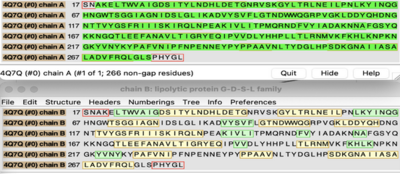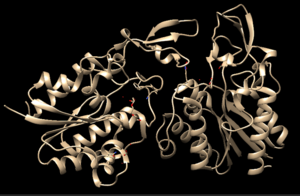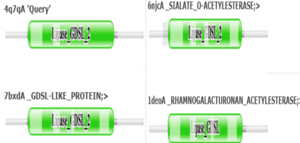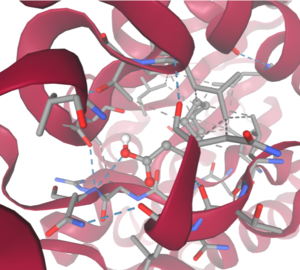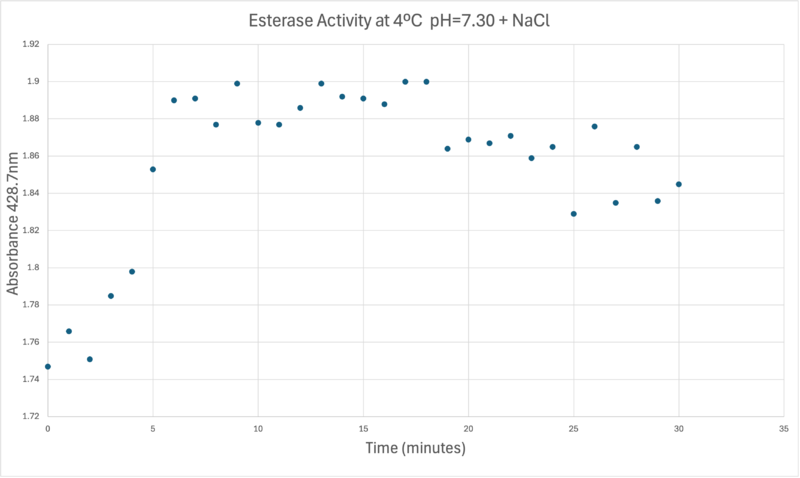Sandbox323
From Proteopedia
(Difference between revisions)
| Line 1: | Line 1: | ||
| - | ==4Q7Q | + | ==4Q7Q Structure and Proposed Functionality== |
| + | |||
| + | (NOTE TO ALL EDITORS: This page is part of a final project for a biochemistry lab at Elizabethtown College. Please do not edit this. -Neil Divins) | ||
4Q7Q is a homodimeric protein complex that originates from the bacterial species Chitinophaga Pinensis and has a mass of 58.5 kDa. It is a member of the SGNH Hydrolase Superfamily with structural and sequential similarities to esterases and lipases. Current evidence suggests it causes the hydrolysis of esters and/or acetyl groups on lipids/lipid-like molecules via a catalytic triad-like active site. | 4Q7Q is a homodimeric protein complex that originates from the bacterial species Chitinophaga Pinensis and has a mass of 58.5 kDa. It is a member of the SGNH Hydrolase Superfamily with structural and sequential similarities to esterases and lipases. Current evidence suggests it causes the hydrolysis of esters and/or acetyl groups on lipids/lipid-like molecules via a catalytic triad-like active site. | ||
| Line 9: | Line 11: | ||
=== General Structure and Origins === | === General Structure and Origins === | ||
| - | 4Q7Q exists | + | 4Q7Q exists as a homodimer Quaternary structure.<ref name="Sequence">4Q7Q. Protein Database, 2014. https://www.rcsb.org/structure/4Q7Q</ref> Analyzing primary and Quaternary structures of 4Q7Q with SPRITE revealed two chains identical in both shape and sequence<ref name="SPRITE">Nadzirin, N.; Gardiner, E.; Willett, P.; Artymiuk, P. J.; Firdaus-Raih, M. 2012. SPRITE and ASSAM: web servers for side chain 3D-motif searching in protein structures. Nucleic Acids Res., 40(Web Server Issue), W380-6.</ref> Each chain is 266 residues long, and the entire complex has a molecular weight of approximately 58.5 kDa.<ref name="Sequence" />. |
| - | [[Image:4Q7QABSequence.png| | + | [[Image:4Q7QABSequence.png|400px|left|thumb| Primary Sequences of the A and B chains of 4Q7Q.<ref name="SPRITE" />.]] |
| - | 4Q7Q primarily | + | 4Q7Q proteins primarily appear in bacterial species.<ref name="Origin">Rio, T. G. D.; et al. Complete genome sequence of Chitinophaga pinensis type strain (UQM 2034). Stand. Genomic. Sci., 2010, 2(1), 87-95. https://pmc.ncbi.nlm.nih.gov/articles/PMC3035255/</ref>. Research reveals how nearly every enzyme with similar sequencing to 4Q7Q is found in bacterium, with a slight exception to eukaryotes.<ref name="SGNH">SGNH hydrolase superfamily. InterPro, 2017. https://www.ebi.ac.uk/interpro/entry/InterPro/IPR036514/</ref> Additionally, the PDB entry for 4Q7Q notes how it potentially can be found in Chitinophaga pinensis, a gram-negative bacterial species which can degrade chitin.<ref name="Origin" />.<ref name="GDSL">Rio, T. G. D.; et al. Complete genome sequence of Chitinophaga pinensis type strain (UQM 2034). Stand. Genomic. Sci., 2010, 2(1), 87-95. https://pmc.ncbi.nlm.nih.gov/articles/PMC3035255/ </ref>. |
=== Family and Superfamily === | === Family and Superfamily === | ||
| - | Research shows that 4Q7Q is a member of the SGNH Hydrolase protein super family. BLAST and InterPro research suggested 4Q7Q best fits this superfamily, and the known conserved residues seen from SPRITE analysis—Serine, Glycine, Asparagine, and Histidine—line up with those observed throughout this family.<ref name="SGNH" /><ref name = "Molgaard">Molgaard, A.; Kauppinen, S.; Larsen, S. Rhamnogalacturonan acetylesterase elucidates the structure and function of a new family of hydrolases. Struct., 2000, 8(4), 373-383. https://www.sciencedirect.com/science/article/pii/S0969212600001180?via%3Dihub</ref>. Notably, this superfamily is also referred to as the GDSL Hydrolase superfamily.<ref name="SGNH" /><ref name="Molgaard" /> | + | Research shows that 4Q7Q is a member of the SGNH Hydrolase protein super family. BLAST and InterPro research suggested 4Q7Q best fits this superfamily, and the known conserved residues seen from SPRITE analysis—Serine, Glycine, Asparagine, and Histidine—line up with those observed throughout this family.<ref name="SGNH" /><ref name = "Molgaard">Molgaard, A.; Kauppinen, S.; Larsen, S. Rhamnogalacturonan acetylesterase elucidates the structure and function of a new family of hydrolases. Struct., 2000, 8(4), 373-383. https://www.sciencedirect.com/science/article/pii/S0969212600001180?via%3Dihub</ref>. Notably, this superfamily is also referred to as the GDSL Hydrolase superfamily.<ref name="SGNH" /><ref name="Molgaard" />. |
| - | [[Image:4Q7QAChain.png| | + | [[Image:4Q7QAChain.png|300px|right|thumb|Chimera-generated representation of the A chain of 4Q7Q.<ref name="Chimera">UCSF Chimera--a visualization system for exploratory research and analysis. Pettersen EF, Goddard TD, Huang CC, Couch GS, Greenblatt DM, Meng EC, Ferrin TE. J Comput Chem. 2004 Oct;25(13):1605-12.</ref>]] |
| - | Regarding what protein family 4Q7Q belongs to, DALI results suggest it is a part of a sub-family of the greater GDSL/SGNH superfamily. A PDB90% DALI search | + | Regarding what protein family 4Q7Q belongs to, DALI results suggest it is a part of a sub-family of the greater GDSL/SGNH superfamily. A PDB90% DALI search labels 4Q7Q as a part of the “Lipolytic Protein G-D-S-L Family,” which refers to enzymes that hydrolyze lipid substrates.<ref name="Akoh">Akoh, C. C.; Lee, G.; Liaw, Y.; Huang, T.; Shaw, J. GDSL family of serine esterases/lipases. Prog. Lipid Res., 2004, 43(6), 534-552. https://pubmed.ncbi.nlm.nih.gov/15522763/</ref>. |
== Structure/Sequence Analysis == | == Structure/Sequence Analysis == | ||
| Line 27: | Line 29: | ||
=== Sequence Analysis === | === Sequence Analysis === | ||
| - | The primary sequence of 4Q7Q shows several conserved sequences between it and esterase-like proteins. A sequence of GDSI—similar to the GDSL sequence seen from its family and superfamily—can be seen between 4Q7Q and enzymes like Isoamyl Acetate-Hydrolyzing Esterase when using DALI.<ref name="DALI">Holm L, Laiho A, Toronen P, Salgado M (2023) DALI shines a light on remote homologs: one hundred discoveries. Protein Science 23, e4519</ref>. Other noteworthy conserved sequences between esterases and 4Q7Q include GxND and DGxH.<ref name="DALI" /> | + | The primary sequence of 4Q7Q shows several conserved sequences between it and esterase-like proteins. A sequence of GDSI—similar to the GDSL sequence seen from its family and superfamily—can be seen between 4Q7Q and enzymes like Isoamyl Acetate-Hydrolyzing Esterase when using DALI.<ref name="DALI">Holm L, Laiho A, Toronen P, Salgado M (2023) DALI shines a light on remote homologs: one hundred discoveries. Protein Science 23, e4519</ref>. Other noteworthy conserved sequences between esterases and 4Q7Q include GxND and DGxH.<ref name="DALI" />. |
| - | [[Image:4Q7QEsteraseConserv.png| | + | [[Image:4Q7QEsteraseConserv.png|300px|left|thumb| Conserved sequences of note between 4Q7Q and Esterases. <ref name="DALI" />.]] |
These enzymes also share similar secondary structures. Segments of alpha-helixes and beta-sheet strands appear and remain nearly entirely conserved throughout esterase analysis. A few conserved coils appear, but these sections do not appear as often as the other two secondary structures. | These enzymes also share similar secondary structures. Segments of alpha-helixes and beta-sheet strands appear and remain nearly entirely conserved throughout esterase analysis. A few conserved coils appear, but these sections do not appear as often as the other two secondary structures. | ||
| Line 35: | Line 37: | ||
[[Image:4Q7QSecondaryEsterases.png|300px|left|thumb| Conserved secondary structures of note between 4Q7Q and Esterases.<ref name="DALI" />.]] | [[Image:4Q7QSecondaryEsterases.png|300px|left|thumb| Conserved secondary structures of note between 4Q7Q and Esterases.<ref name="DALI" />.]] | ||
| - | Similar conserved sequences could be found between 4Q7Q and lipases. The GDSI, GxND, and DGxH sequences can be seen from lipases like | + | Similar conserved sequences could be found between 4Q7Q and lipases. The GDSI, GxND, and DGxH sequences can be seen from lipases like 7BXD.<ref name="DALI" /.><ref name="7BXD">7BXD. Protein Database, 2021. https://www.rcsb.org/structure/7BXD</ref> The same secondary structure segments can also be located in the lipases analyzed. |
=== Structural Analysis === | === Structural Analysis === | ||
| Line 41: | Line 43: | ||
Right-hand SPRITE analysis revealed 4Q7Q exhibited residues like those seen from enzymes operating with acetyl-like substrates.<ref name="SPRITE" /> Specifically, residues Ser. 30, Gly. 69, Asn. 97, Asp. 251, and His. 254 on the A and B chains of 4Q7Q line up with similarly positioned residues on esterases like Platelet-Activating Factor Acetylhyd (PAFA), which exhibited an RMSD of 0.25 angstroms when compared to 4Q7Q.<ref name="SPRITE" /> | Right-hand SPRITE analysis revealed 4Q7Q exhibited residues like those seen from enzymes operating with acetyl-like substrates.<ref name="SPRITE" /> Specifically, residues Ser. 30, Gly. 69, Asn. 97, Asp. 251, and His. 254 on the A and B chains of 4Q7Q line up with similarly positioned residues on esterases like Platelet-Activating Factor Acetylhyd (PAFA), which exhibited an RMSD of 0.25 angstroms when compared to 4Q7Q.<ref name="SPRITE" /> | ||
| - | [[Image:4Q7QPAFASPRITE.png| | + | [[Image:4Q7QPAFASPRITE.png|300px|right|thumb|SPRITE-based alignment between motifs from 4Q7Q and PAFA.<ref name="SPRITE" />.]] |
Other proteins with similar motifs of note are Thioesterase I and Rhamnogalacturonan Acetylesterase, with RMSD values of 0.46 and 0.61, respectively.<ref name="SPRITE" /><ref name="Molgaard" /> These alignments focus on the same active site as PAFA did, suggesting the acetyl-like substrates 4Q7Q focuses on are similar to esters. | Other proteins with similar motifs of note are Thioesterase I and Rhamnogalacturonan Acetylesterase, with RMSD values of 0.46 and 0.61, respectively.<ref name="SPRITE" /><ref name="Molgaard" /> These alignments focus on the same active site as PAFA did, suggesting the acetyl-like substrates 4Q7Q focuses on are similar to esters. | ||
| - | |||
| - | These residues are also similar to those seen from the mechanisms involved with the proteins in the SGNH hydrolase superfamily and lipolytic GDSL protein.<ref name="SGNH" /><ref name="Molgaard" /> Serine, Histidine, and Aspartate are the exact residues seen in this motif and members of these groupings.<ref name="SGNH" /><ref name="Molgaard" /> | ||
PFAM graphics from DALI revealed significant structural equivalence between 4Q7Q, a lipase-like protein, Rhamnogalacturonan Acetylesterase, and Sialate O-acetylesterase.<ref name="DALI" /> | PFAM graphics from DALI revealed significant structural equivalence between 4Q7Q, a lipase-like protein, Rhamnogalacturonan Acetylesterase, and Sialate O-acetylesterase.<ref name="DALI" /> | ||
| - | [[Image:4Q7QpfamLipases.png| | + | [[Image:4Q7QpfamLipases.png|300px|left|thumb|Pfam similarities between 4Q7Q and other enzymes.<ref name="DALI" />.]] |
4Q7Q’s superfamily also supports its SPRITE-derived hypothetical functionality. Rhamnogalacturonan Acetylesterase—the enzyme with one of the best SPRITE-based alignment relative to 4Q7Q—is a member of this family.<ref name="Molgaard" /><ref name="SPRITE" /> Proteins in this family are also known for containing a “unique hydrogen bond network that [stabilizes]” the active site.<ref name="SPRITE" /> | 4Q7Q’s superfamily also supports its SPRITE-derived hypothetical functionality. Rhamnogalacturonan Acetylesterase—the enzyme with one of the best SPRITE-based alignment relative to 4Q7Q—is a member of this family.<ref name="Molgaard" /><ref name="SPRITE" /> Proteins in this family are also known for containing a “unique hydrogen bond network that [stabilizes]” the active site.<ref name="SPRITE" /> | ||
| Line 60: | Line 60: | ||
Grosdidier A, Zoete V, Michielin O. SwissDock, a protein-small molecule docking web service based on EADock DSS. Nucleic Acids Res. 2011, 39 (Web Server issue), W270-W277. DOI: 10.1093/nar/gkr366</ref><ref name="SwissDockThree"> Eberhardt J, Santos-Martins D, Tillack AF, Forli S. AutoDock Vina 1.2.0: New Docking Methods, Expanded Force Field, and Python Bindings. J. Chem. Inf. Model., 2021, 61 (8), 3891–3898, DOI: 10.1021/acs.jcim.1c00203</ref><ref name="SwissDockFour">Trott O, Olson AJ. AutoDock Vina: Improving the Speed and Accuracy of Docking with a New Scoring Function, Efficient Optimization, and Multithreading. J. Comput. Chem., 2010, 31 (2), 455–461, DOI: 10.1002/jcc.21334</ref> These ligands may be ill-suited to act as substrates for 4Q7Q as they are remarkably polar, and lipids—one of the potential categories of substrates for 4Q7Q—are mostly non-polar.<ref name="SwissDockOne" /><ref name="SwissDockTwo" /><ref name="SwissDockThree" /><ref name="SwissDockFour" /> | Grosdidier A, Zoete V, Michielin O. SwissDock, a protein-small molecule docking web service based on EADock DSS. Nucleic Acids Res. 2011, 39 (Web Server issue), W270-W277. DOI: 10.1093/nar/gkr366</ref><ref name="SwissDockThree"> Eberhardt J, Santos-Martins D, Tillack AF, Forli S. AutoDock Vina 1.2.0: New Docking Methods, Expanded Force Field, and Python Bindings. J. Chem. Inf. Model., 2021, 61 (8), 3891–3898, DOI: 10.1021/acs.jcim.1c00203</ref><ref name="SwissDockFour">Trott O, Olson AJ. AutoDock Vina: Improving the Speed and Accuracy of Docking with a New Scoring Function, Efficient Optimization, and Multithreading. J. Comput. Chem., 2010, 31 (2), 455–461, DOI: 10.1002/jcc.21334</ref> These ligands may be ill-suited to act as substrates for 4Q7Q as they are remarkably polar, and lipids—one of the potential categories of substrates for 4Q7Q—are mostly non-polar.<ref name="SwissDockOne" /><ref name="SwissDockTwo" /><ref name="SwissDockThree" /><ref name="SwissDockFour" /> | ||
| - | [[Image:DecanoateDocking.png| | + | [[Image:DecanoateDocking.png|300px|right|thumb|SwissDock-based analysis of the intermolecular interactions between Decanoate and 4Q7Q's proposed active site <ref name="SwissDockOne" /><ref name="SwissDockTwo" /><ref name="SwissDockThree" /><ref name="SwissDockFour" />]] |
Despite this, these ligands show noticeable hydrophobic interactions with the active site. This implies 4Q7Q uses hydrophobic regions to help guide substrates into the right orientation for enzymatic processes. This also further supports the possibility that 4Q7Q primarily operates with hydrophobic lipid-based substrates. This also explains why Methyl Acetate exhibited a relatively weaker affinity for 4Q7Q, as its smaller structure prevented hydrophobic interactions. | Despite this, these ligands show noticeable hydrophobic interactions with the active site. This implies 4Q7Q uses hydrophobic regions to help guide substrates into the right orientation for enzymatic processes. This also further supports the possibility that 4Q7Q primarily operates with hydrophobic lipid-based substrates. This also explains why Methyl Acetate exhibited a relatively weaker affinity for 4Q7Q, as its smaller structure prevented hydrophobic interactions. | ||
| - | [[Image:4Q7QDockingEnergies.png| | + | [[Image:4Q7QDockingEnergies.png|300px|left|thumb|SwissDock-based analysis of the intermolecular interactions between Decanoate and 4Q7Q's proposed active site <ref name="SwissDockOne" /><ref name="SwissDockTwo" /><ref name="SwissDockThree" /><ref name="SwissDockFour" />]] |
=== Hypothetical Function === | === Hypothetical Function === | ||
| Line 86: | Line 86: | ||
[[Image:Absorbancelongph7cold.png|800px|left|]] | [[Image:Absorbancelongph7cold.png|800px|left|]] | ||
| - | 50uL of purified protein from the first elution was added to 3mL of cold 1mg/mL PNPA at pH=7.30. Chloride ion cofactor was provided by the 2M HCl. | + | 50uL of purified protein from the first elution was added to 3mL of cold 1mg/mL PNPA at pH=7.30. Chloride ion cofactor was provided by the 2M HCl. A change in absorbance at 428.7nm over time was noted. The time range of the run did not produce a linear response. The absorbance increased for the first ten minutes and plateaued. The time 0 to 10 minutes was used to create the third figure. |
| + | |||
| + | [[Image:Absorbancecoldph7.jpg|800px|left|]] | ||
== References == | == References == | ||
<references/> | <references/> | ||
Revision as of 04:43, 28 April 2025
4Q7Q Structure and Proposed Functionality
(NOTE TO ALL EDITORS: This page is part of a final project for a biochemistry lab at Elizabethtown College. Please do not edit this. -Neil Divins)
4Q7Q is a homodimeric protein complex that originates from the bacterial species Chitinophaga Pinensis and has a mass of 58.5 kDa. It is a member of the SGNH Hydrolase Superfamily with structural and sequential similarities to esterases and lipases. Current evidence suggests it causes the hydrolysis of esters and/or acetyl groups on lipids/lipid-like molecules via a catalytic triad-like active site.
| |||||||||||
